If you are asked to describe an egg, the first thing your mind would likely conjure up is a normal, white egg laid by a hen, a lizard, or even a snake. But just as the animal kingdom is incredibly diverse, so are the colors of their eggs. Some animals lay beautiful green, brown, and even pink eggs. Considered to be one of the most attractive are the blue eggs laid by birds.
Why do birds lay blue eggs? Well, the blue color has biliverdin to thank for that. Biliverdin is a bile pigment that gives birds’ eggs their blue color. The deepness of the blue in the eggshell depends on the concentration of biliverdin. Sometimes the color might range from a greenish-blue, or a paler blue and every color in between. Here are 15 birds that lay blue eggs.
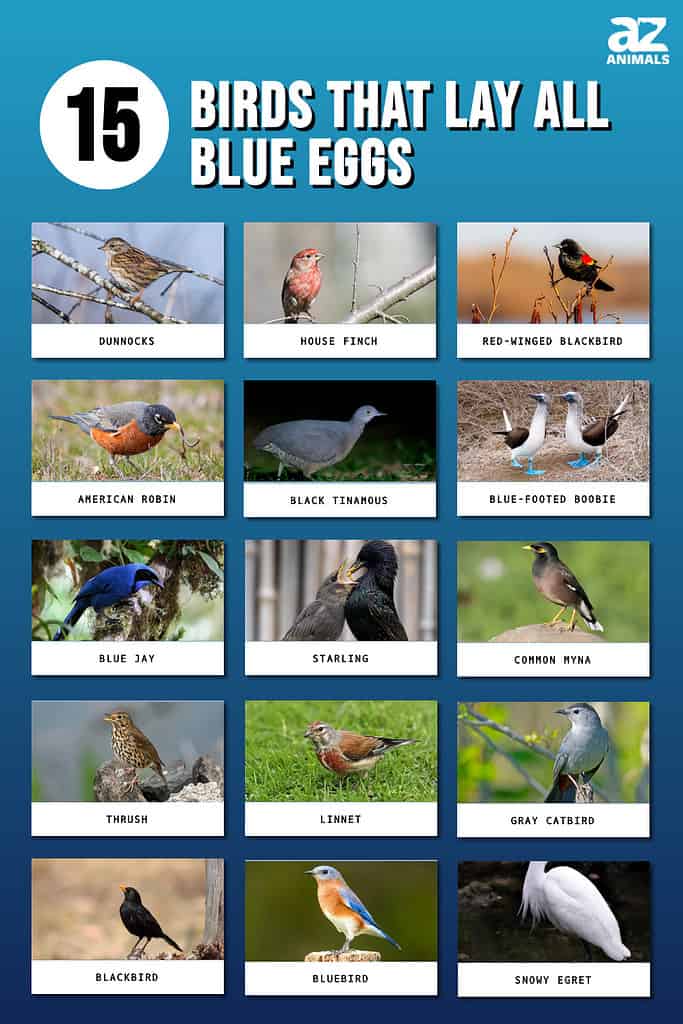
1. Dunnocks
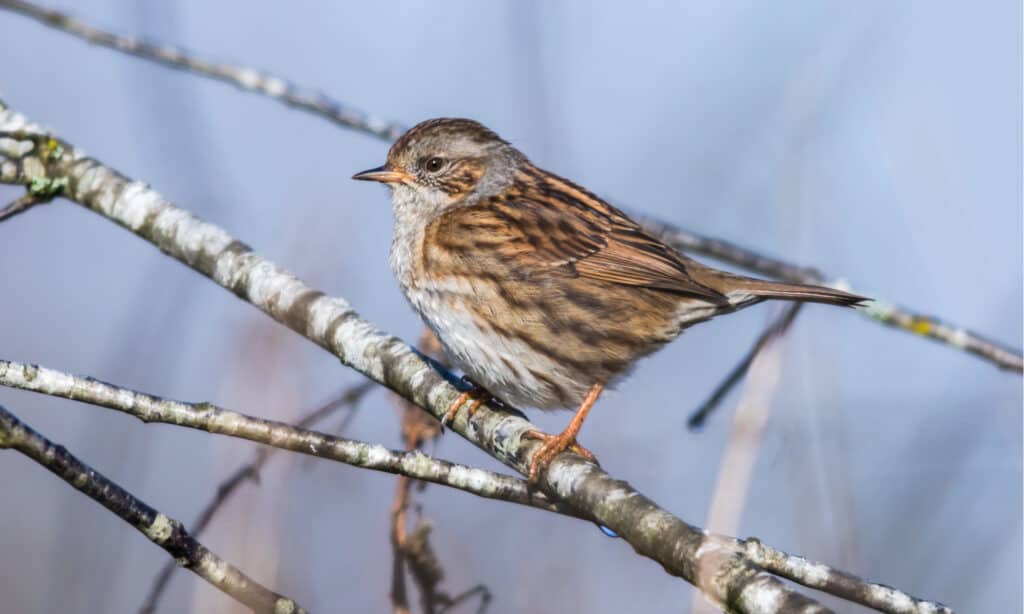
Female dunnocks lay a clutch of four to five glossy blue eggs.
©Rosemarie Kappler/Shutterstock.com
Dunnocks are small brown and gray birds with short black streaks on their plumage. They are native to parts of Eurasia and currently inhabit European and North African countries, including the United Kingdom, Lebanon, Algeria, Egypt, Iran, Croatia, and Bulgaria. Also called “hedge sparrows,” they aren’t particularly outgoing and are known to be shy and quiet creatures.
Female dunnocks lay a clutch of four to five glossy blue eggs. Their eggs rarely have any speckles and are a brilliant blue. Dunnock eggs are small and only measure about 0.6 inches in width. Female dunnocks incubate their eggs for 12 to 13 days.
2. House Finches
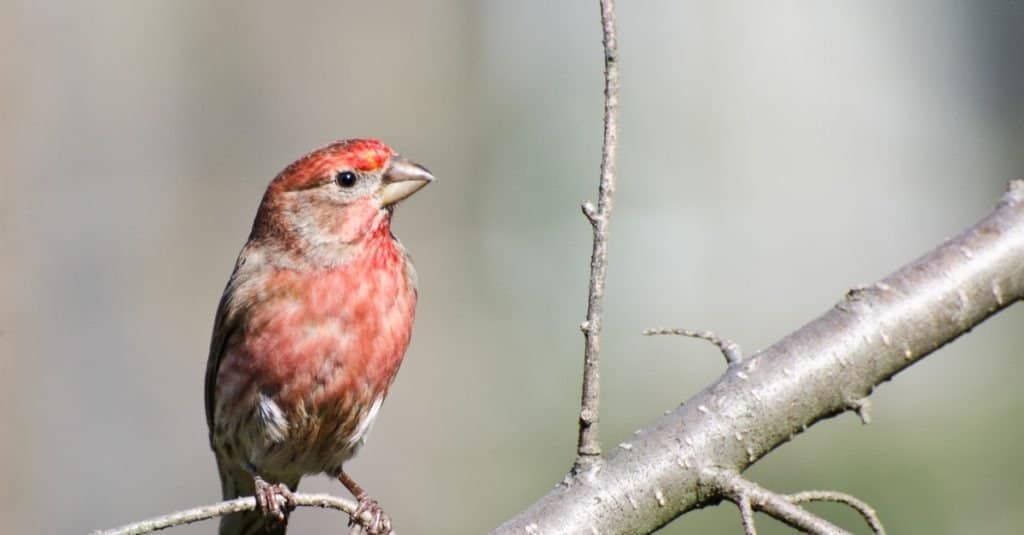
House finches lay four or five eggs from spring to summer.
©rck_953/Shutterstock.com
House finches are brown birds with grayish wings and conical bills. Adult male house finches typically have red plumage around the face and upper breast. They are native to the western parts of North America and can be found throughout the United States, Canada, and Mexico.
House finches lay four or five eggs from spring to summer. Their eggs are a pale bluish-green and may sometimes have light lavender or black markings. House finch eggs are quite small and measure a modest half-inch in width. They are incubated for 13 to 14 days.
3. Red-Winged Blackbirds

Red-winged blackbirds typically lay between two to four oval, light blue-green eggs per clutch.
©iStock.com/Michael-Tatman
Red-winged blackbirds are common throughout North America except in desert, arctic, and high mountain regions. They are migratory birds and can be found in the USA, Canada, Mexico, and Costa Rica. As their name suggests, the male red-winged blackbird is black with red and yellow patches on their broad shoulders. The females are not as colorful. They are dark brown and have paler breasts.
Red-winged blackbirds typically lay between two to four oval, light blue-green eggs per clutch. Their eggs have black or brown markings and measure 0.9 to 1.1 inches in width. The eggs are incubated for 11 to 13 days.
4. American Robins
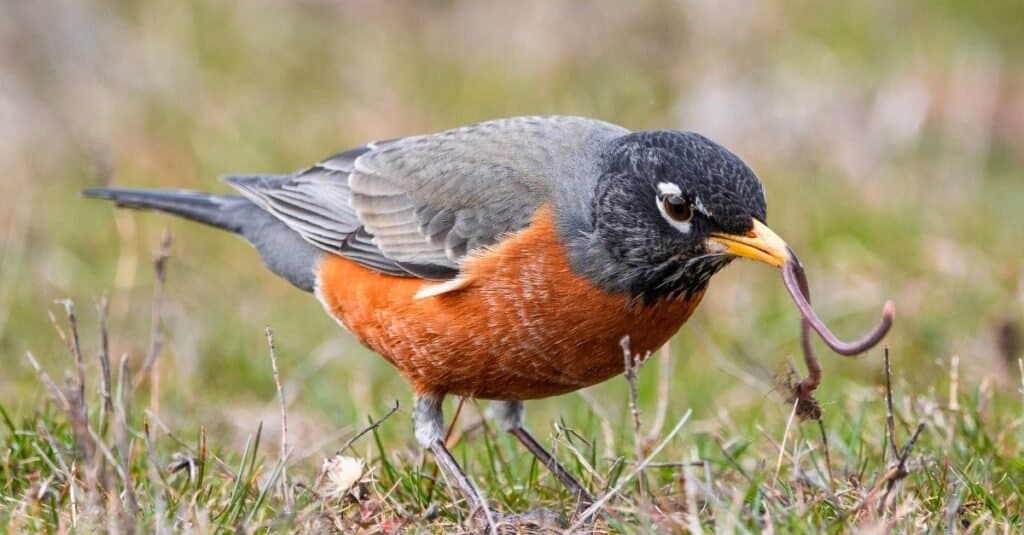
American robins lay three to five light blue eggs per clutch.
©iStock.com/Mason Maron
American robins are found throughout the United States. Some migrate to South America to breed, while others prefer to breed where they are. Robins have dark gray wings and orange chests.
American robins lay three to five light blue eggs per clutch. These eggs measure 0.8 inches wide. Male robins tend to be more fatherly and take on more parental responsibility if the eggs are bright enough. The American robin incubates her eggs for 12 to 14 days.
5. Black Tinamous
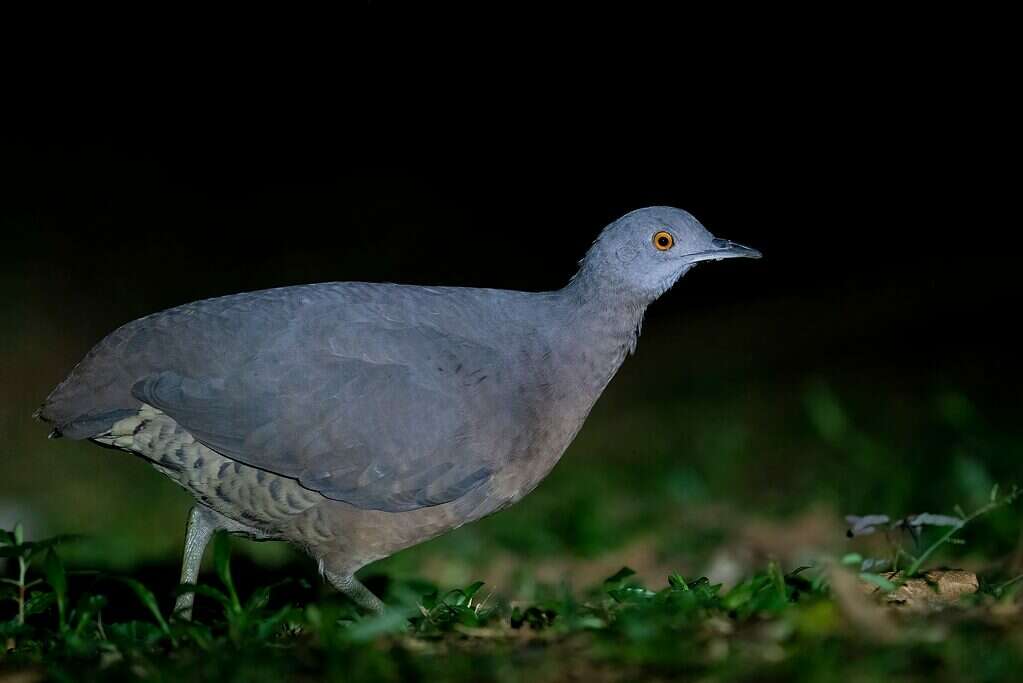
Black tinamous build their nests on the ground.
©Rob Jansen/Shutterstock.com
Black tinamous are stocky, ground-dwelling birds. Although their name suggests otherwise, this bird is actually slate gray and not black. The females are larger than the males. They are native to the Andes region of South America and can be found in Colombia.
Black tinamous build their nests on the ground. They lay glossy, bright blue eggs from March to November. Only two eggs have ever been officially recorded for the black tinamou.
6. Blue-footed Boobies
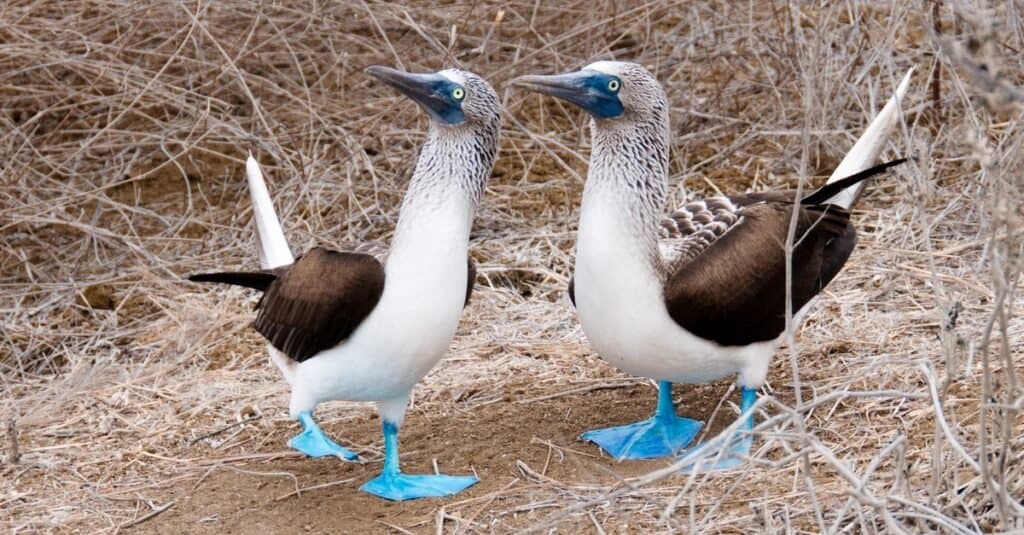
The eggs of the blue-footed booby are pale blue, and their nests are on the ground.
©tamara bizjak/Shutterstock.com
The blue-footed booby is one of the most popular birds around. This is because of their characteristic blue, webbed feet, which is a result of carotenoid pigments obtained from their fresh fish diet. The males use their bright blue feet to attract mates. The blue-footed booby can be found in the coastal regions of Central and South America in countries like Mexico down to Peru.
The eggs of the blue-footed booby are pale blue, and their nests are on the ground. They lay two to three eggs per clutch, taking about 45 days to hatch. Both male and female boobies incubate their eggs with their feet.
7. Blue Jays

Blue jays lay their eggs in nests 10 to 25 feet high in trees.
©Uwe Bergwitz/Shutterstock.com
Blue jays are gorgeous perching birds native to eastern North America and are located in the United States and Canada. They are mostly blue with white heads and off-white undersides. Their white heads are accented with black.
Blue jays lay two to seven eggs per clutch. The eggs are usually blue but can also be other colors, such as yellow or green, and they always have brown spots. Blue jays lay their eggs in nests 10 to 25 feet high in trees.
8. Starlings
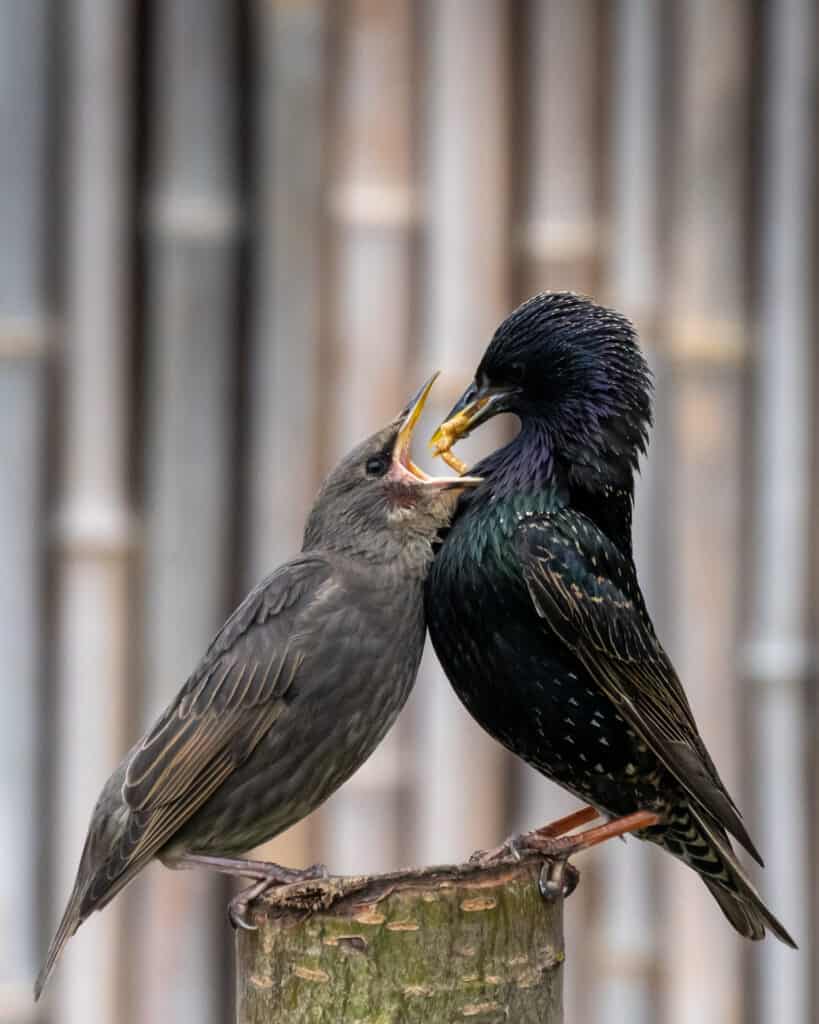
Fledgling starlings are a soft brown color without the iridescence or “stars” that they will develop as adults.
©Somni4uk/Shutterstock.com
Starlings are beautiful birds whose appearance might be misleading at first glance. This is because some of them look dark, but upon a closer look, their plumage is actually iridescent. They are native to Europe, Asia, Africa, Australia, and the Pacific Islands in countries like Ethiopia, Kenya, Somalia, New Zealand, and Spain. They are considered an invasive species.
Starlings lay blue, white, and green eggs. They also prefer to build their nests in man-made structures. They are very gregarious animals and can live in colonies of up to one million birds.
9. Common Myna
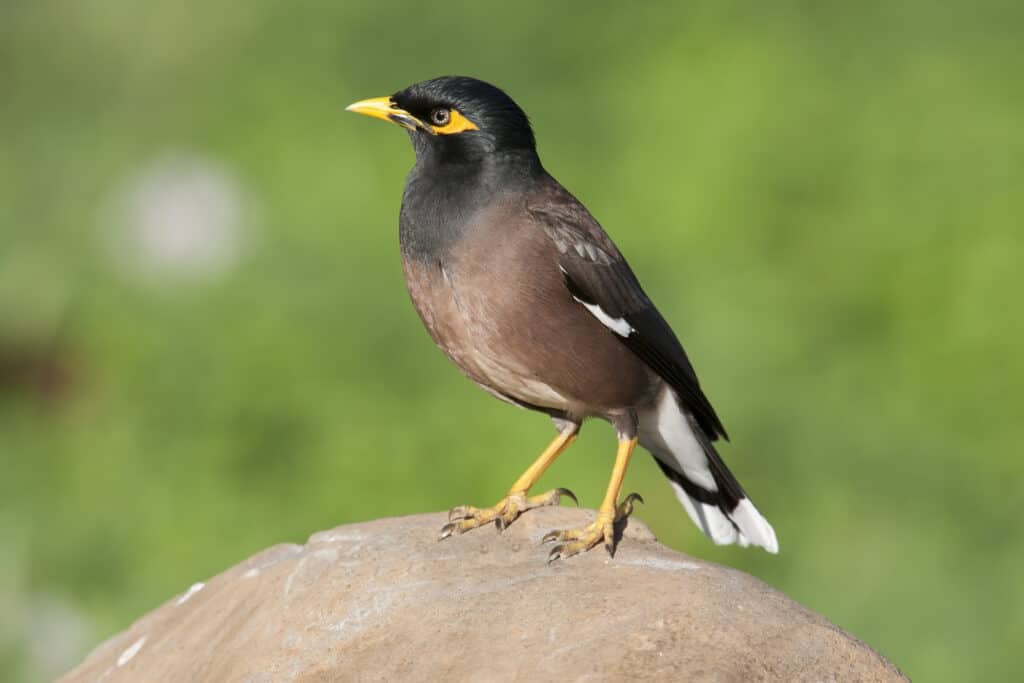
The common myna lays four to six turquoise or blue-green eggs.
©Stubblefield Photography/Shutterstock.com
The common myna is native to Asia and is considered an invasive species in India. They have dark heads, brown bodies, and two yellow patches on their face. Their beaks and legs are also yellow. They are mimicking birds and can learn up to 100 words.
The common myna lays four to six turquoise or blue-green eggs. The eggs are incubated for a period of 17 to 18 days.
10. Thrushes
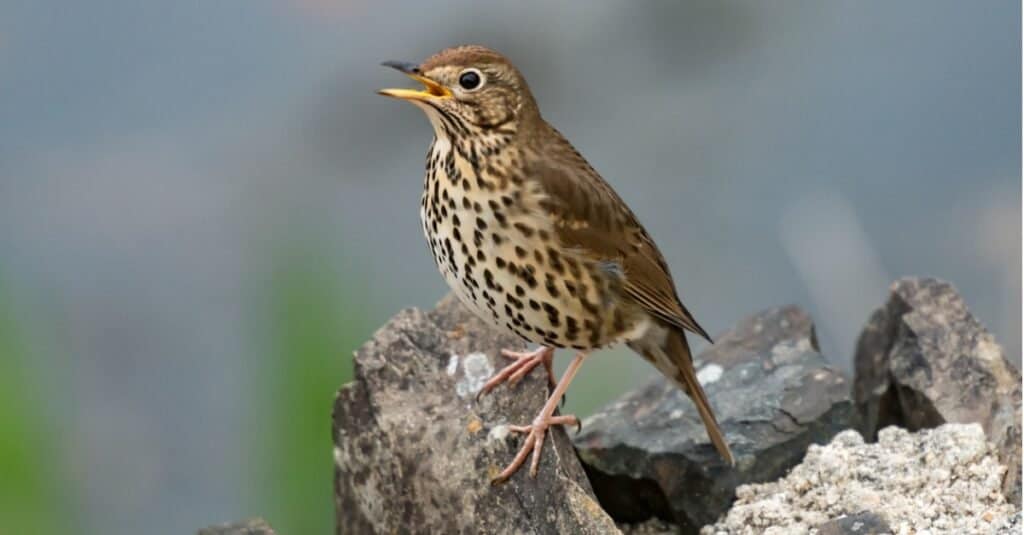
In between songs,
song thrushes
often erupt into harsh calls.
©iStock.com/bearacreative
Thrushes are a family of perching birds. They are small to medium-sized birds with plump bodies. Thrushes typically live in woodland regions, and most species build their nests in tree branches. Most thrushes have gray or brown plumage with speckled feathers on their undersides.
Thrush eggs are light blue or bluish-green and speckled with small dark spots, usually at the bigger end of the egg. This color and pattern varies between thrush species. Some species do not have spots on their eggs. Thrushes lay about two to six eggs in at least one brood per year and sometimes two.
11. Linnets
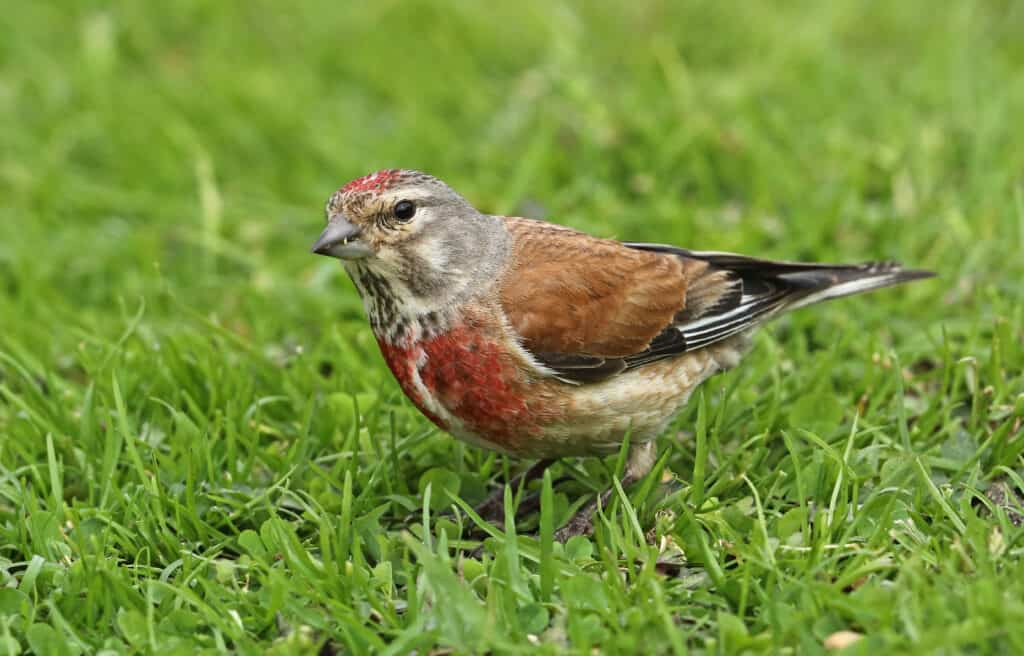
Male linnets change color during mating season.
©Neil Bowman/Shutterstock.com
Linnets are slender birds with brown, white, and gray plumage. The males have red head patches and red breasts, while the females and juveniles do not. Linnets can be found in countries like Scotland, China, Italy, and Greece.
Linnets lay four to six speckled blue eggs from April to July. These eggs are incubated for 14 days.
12. Gray Catbirds
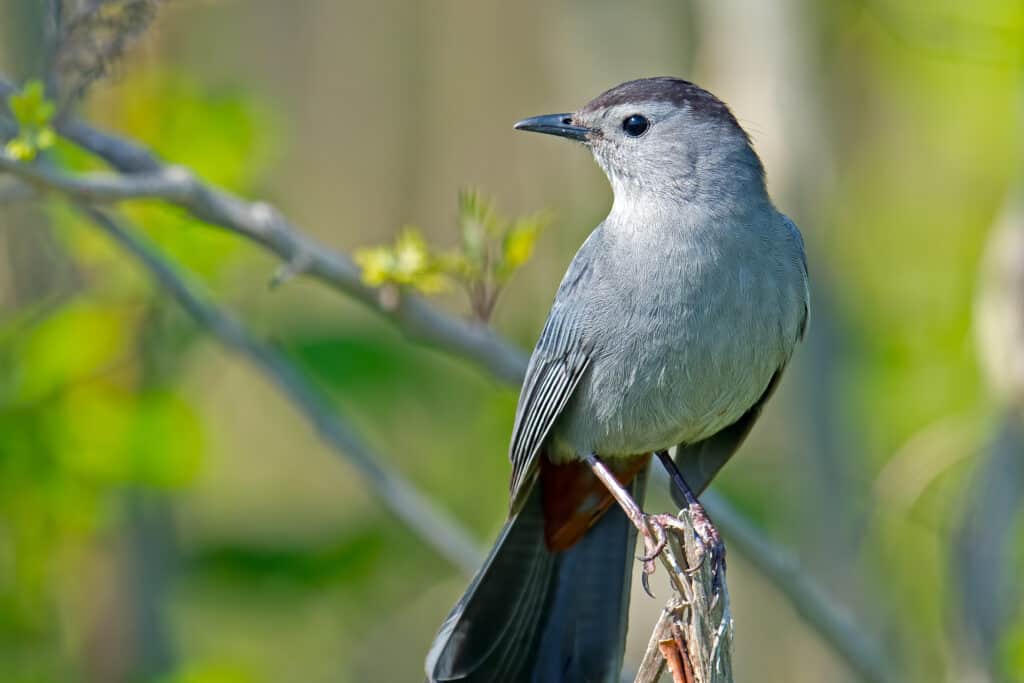
Gray catbirds lay bright turquoise green eggs that are speckled with red.
©Brian E. Kushner/Shutterstock.com
Gray catbirds are called that because of their unique mewing sound, which actually sounds like a cat’s meow. They are located in North and Central America, precisely the United States, Mexico, and parts of the Caribbean islands.
Gray catbirds lay bright turquoise green eggs that are speckled with red. They lay one to six eggs, usually twice per season. These eggs are about half an inch wide and one inch long. The birds incubate their eggs for 12 to 15 days.
13. Blackbirds
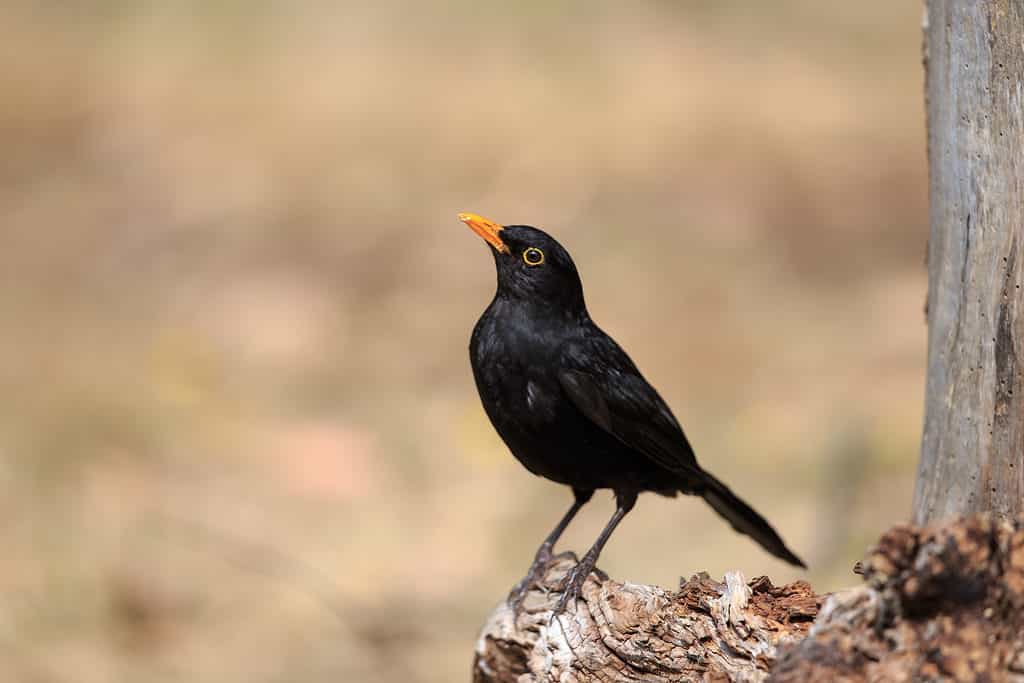
Blackbirds lay three to five small eggs.
©Edwin Godinho/Shutterstock.com
Also called the Eurasian blackbird, this bird has a round head and a pointed tail and is a thrush species. The males are black with yellow rings around their eyes and bright yellow-orange bills, while the females are dark brown with dull yellowish-brown bills.
Blackbirds lay three to five small eggs. Their eggs are blue-green with brown speckles. Both parents incubate the eggs for 13 to 14 days. Blackbirds use the same nest each year to lay their eggs during the breeding season from August to February.
14. Bluebirds
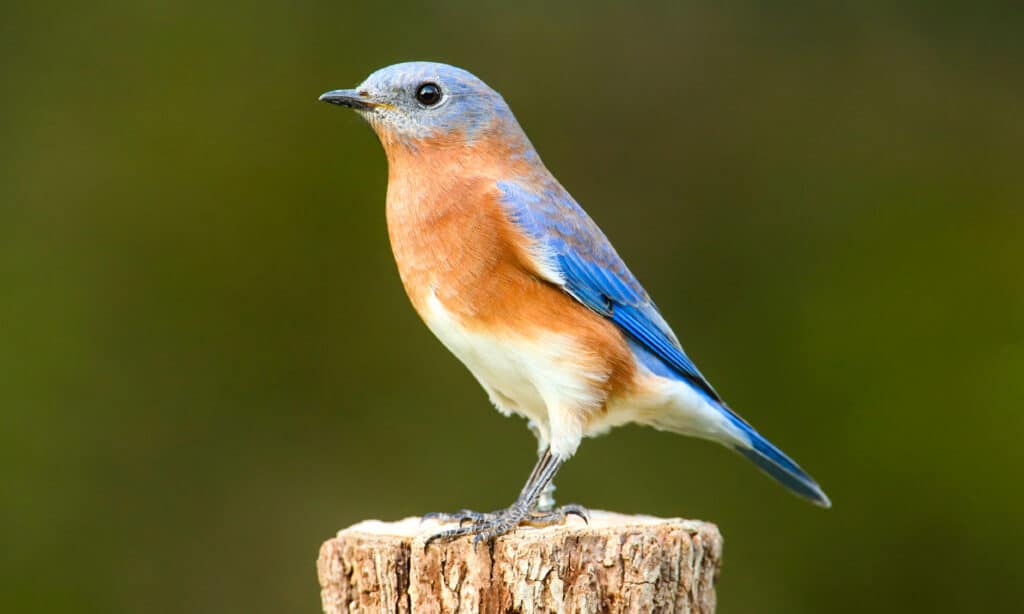
Bluebirds lay two to eight eggs per clutch.
©Steve Byland/Shutterstock.com
Bluebirds are native to North America and have brilliant blue plumage, which is sometimes paired with rose beige. The females are not as brightly colored as the males.
Bluebirds lay two to eight eggs per clutch. Their eggs are usually powder blue with no spots at all and measure 0.6 to 0.9 inches in width. Sometimes, however, bluebirds lay white eggs, but this only happens about 4 to 5% of the time. Depending on the bluebird species, the incubation time may take anywhere from 11 to 17 days.
15. Snowy Egrets
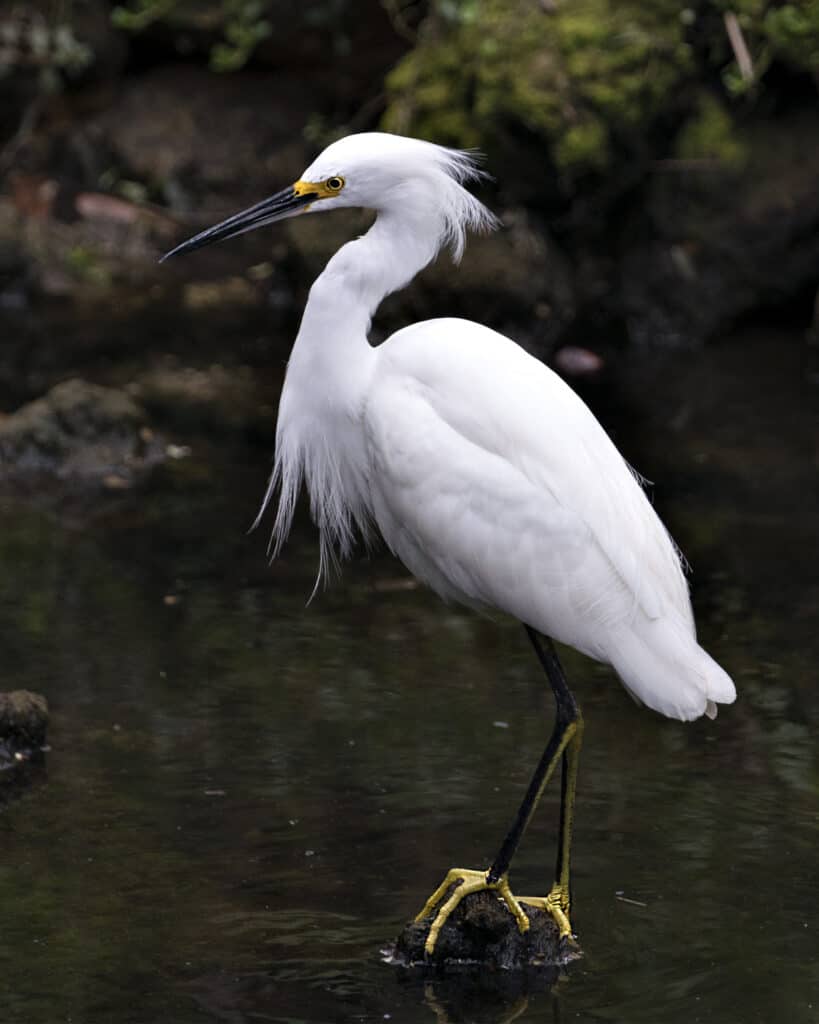
The snowy egret lives on the Gulf Coast year-round.
©iStock.com/Rejean Bedard
Snowy egrets are small white herons. They are pure white with black legs, black bills, and yellow feet. They can be found in countries such as the United States, Canada, the West Indies, and Argentina.
Snowy egrets lay two to six greenish-blue eggs that are 0.9 to 1.3 inches wide and 1.6 to 1.7 inches long. They spend 24 to 25 days incubating their eggs before they hatch.
What Bird Lays Purple Eggs?
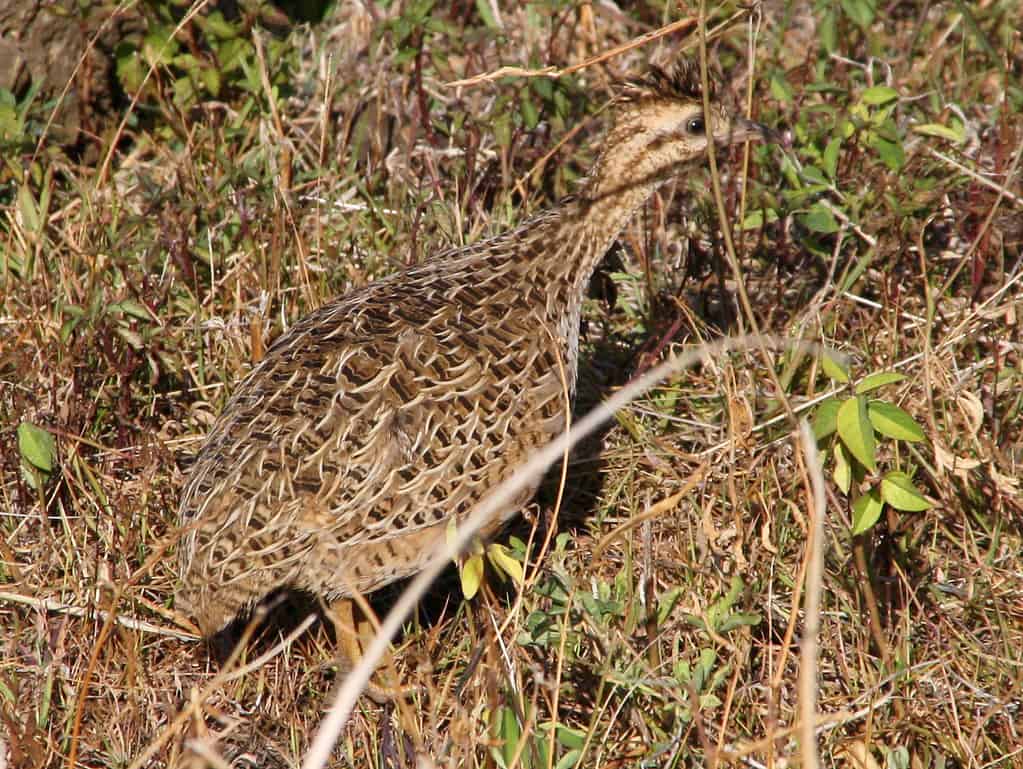
Chilean Tinamou (
Nothoprocta perdicaria) are birds that lay eggs of a purple color.
©Opisska, CC BY-SA 4.0 – License
The most well-known egg of color can be said to belong to the robin, a color that even the department store, Tiffany & Co., is known for. Although their color is trademarked as ‘Tiffany Blue’, the color has quite often been referred to as ‘robin’s egg blue’. While there are many birds that lay blue eggs, this is not the only colored shade found in the aviary world.
Eggs can be found in a variety of colors besides blue. Of course, the most common egg colors are white and brown, but you may discover that they come in shades of pink, green, and purple. There is a chicken-like bird endemic to Chile that lays beautiful purple eggs. The Chilean Tinamou (Nothoprocta perdicaria), common in central Chile, is known for its dark, often shiny, purple egg, although depending on the species it may also be emerald green or reddish-purple.
The photo featured at the top of this post is © Neil Bowman/Shutterstock.com
Sources
- Wikipedia, Available here: https://en.wikipedia.org/wiki/Common_linnet
- Wikipedia, Available here: https://en.wikipedia.org/wiki/Bluebird
- Wikipedia, Available here: https://en.wikipedia.org/wiki/Common_blackbird
- ScienceDaily, Available here: https://www.sciencedaily.com/releases/2016/05/160527190410.htm
- Cornell University, Available here: https://www.allaboutbirds.org/guide/Red-winged_Blackbird/id
- , Available here: https://nhpbs.org/natureworks/bluebooby.htm#:~:text=The%20female%20blue%2Dfooted%20booby,the%20eggs%20using%20their%20feet.
- Wikipedia, Available here: https://en.wikipedia.org/wiki/House_finch
- , Available here: https://worldanimalfoundation.org/birds/what-bird-lays-blue-eggs/#:~:text=The%20most%20common%20species%20known,Tinamou%2C%20to%20name%20a%20few.
FAQs (Frequently Asked Questions)
What makes blue eggs?
The bile pigment known as biliverdin is responsible for the blue hue of some birds’ eggs. This pigment is deposited during the formation of the egg shell in the shell gland. The higher the concentration of biliverdin deposited, the bluer the egg will be and vice versa.
Why do some birds make blue eggs and others white?
Studies show that birds make blue eggs as an evolutionary mechanism meant to protect their eggs from the harsh effects of sunlight. Biliverdin has been shown to do this. In areas with little sunlight, the birds typically lay white eggs instead of blue ones.
Are blue eggs healthier than white or brown eggs?
The simple answer is nope. All eggs laid by a single species of bird have the same nutrient content. For example, brown and white chicken eggs have the same nutrition value.
Thank you for reading! Have some feedback for us? Contact the AZ Animals editorial team.






